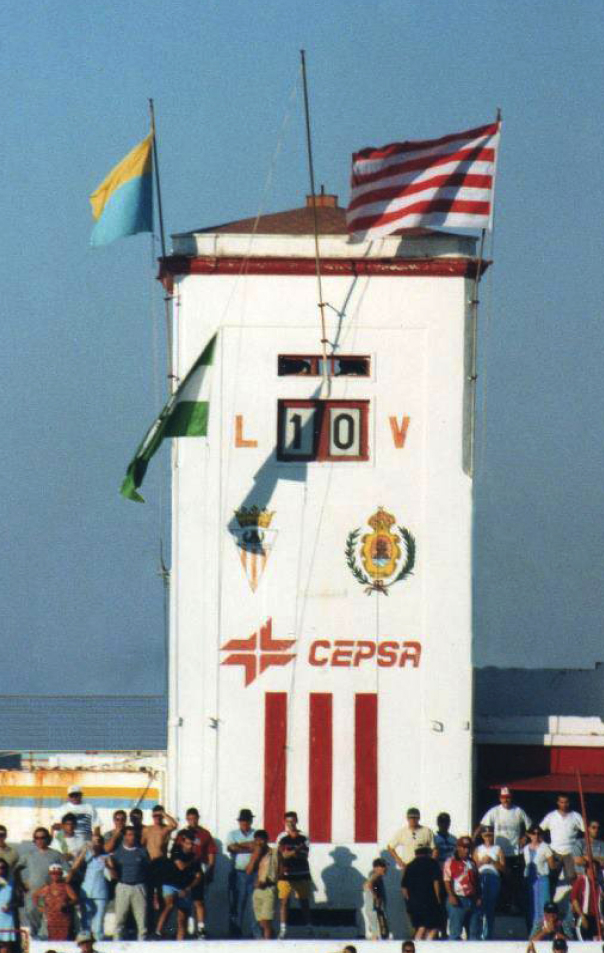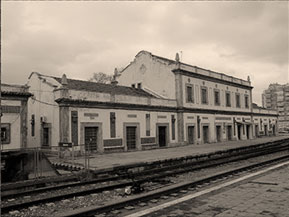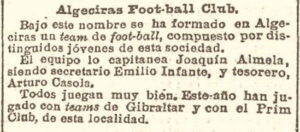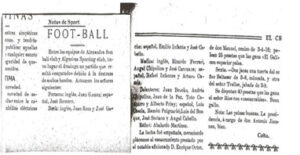Reparto de puntos ante el Recreativo Granada (1-1)
El Algeciras CF encaraba una nueva jornada en el estadio Nuevo Mirador para recibir el….
[get_the_date]

The team was relegated the following season, which sparked a period of economic and sporting difficulties, culminating in relegation just three years later, in 1986, to Regional Andaluza due to non-payments to the Royal Spanish Football Federation (RFEF, its acronym in Spanish).
This was followed by several years in which the club hopped back and forth between Tercera División and Segunda División B until the 2002-2003 season when the club was promoted to Segunda División Española for the fourth time in its history after defeating Bilbao Athletic. In the 2002-2003 season, the Club was proclaimed champion of Group IV in Segunda “B” and, after an incredible season, got their long-awaited promotion to 2ªA.
A few years earlier, in 1999, the Estadio Nuevo Mirador had been inaugurated with a match against Real Betis, the latter winning the match 1-0. This new stadium, with a capacity for 7,500 fans, was to signal the dawn of a new era for the Club. However, unfortunately the club was going through some financial issues that ended up being reflected on the pitch.
In the 2004-2005 season, the team was relegated to Segunda División B, in 2005-2006 to Tercera and after a season of not paying the coaching staff and squad, the team was relegated once again to Primera División Regional Andaluza because it was unable to pay the debts owed to its squad in the 2007-08 season.
In recent years, the club has bounced back and, after being promoted at the first attempt to Tercera División just a season after being relegated due to aforementioned non-payments to 1ª División Regional Andaluza, after several unsuccessful seasons in Tercera División, they were promoted to the bronze category in the 2012-13 season in a play-off against CD Tropezón, a team from Cantabria. The team lost the first leg 1-0. However, a week later and at a sold-out Nuevo Mirador, they were promoted once again after coming back to defeat the Cantabrians 4-0.
Not without first celebrating the club’s centenary in style! In the 2011-12 season, dozens of events were organised by the Centenary Commission to celebrate the 100 glorious years of our club. Many other clubs got in on our centenary celebrations in one way or another; some even played a match in Nuevo Mirador, such as Sevilla FC with its star-studded squad who we played against in the so-called “Centenary Match”, or Real Betis Balompié that would also pay us a visit several months later. Malaga didn’t want to miss out on the centenary celebrations either, so in July 2013 they showed up in Algeciras to play a match.
We can confirm that football made its way to Spain, Andalusia and Algeciras through the British towards the end of the 19th century, in particular as a result of commercial and industrial aspects. It was the immigrant workers settled in Minas de Ríotinto (Huelva) and in Vigo, who played the first matches some time around 1870.
In the province of Cadiz, on the one hand, it spread to Jerez due to the interest that the British had in their wineries and, on the other hand, through Campo de Gibraltar, where there are two points of entry: through Gibraltar, driven by the British Armed Forces stationed there, and through Algeciras, through the construction of the railway line between Algeciras and Bobadilla by an English company.
Due to the strategic geographical location of Algeciras, the British company Greenwood Company Ltd., whose headquarters were in London, had been awarded the concession of the Bobadilla-Algeciras railway line in 1888 with an extension to the enclave of Gibraltar, setting up a new company called The Algeciras-Gibraltar Railway Company Ltd. that would go on to build and operate this section.
This led to the arrival of a significant number of British people after the railway was inaugurated in 1890, some of whom settled in the area for the subsequent construction of hotels in Algeciras and Ronda.

Old train station, built in 1892. Photo Juan L.
Espinosa Gibraltar already had a decent number of clubs, with a popular league and whose influence was the key to this sport being played by people living in Algeciras.
The origin of football in Algeciras is linked to the British and the railway. Football in the city officially goes back to 1902.
This was th e year that a request was made to the town council to set aside some municipal land to play football on. The application was registered in 1902 by Ernesto Coombe, an engineer working for the Algeciras-Gibraltar Railway Company, who asked the Town Council about the availability of a plot of land near the Reina Cristina Hotel. The Town Council subsequently rejected the request, but its importance is worth highlighting as it is the city’s first official football-related document.Die Besten iPhone 15 Pro Max Hüllen für Mehr Tragekomfort cater to consumers seeking both style and functionality. These cases are designed to enhance the user experience by providing superior grip and protection while complementing the sleek design of the iphone 15 pro max case. With various materials and designs available, users can find the perfect balance between aesthetics and practicality, ensuring their device remains secure and comfortable to carry throughout the day.
Thanks to the British and the demand for football among locals, from 1905, the first modest teams were put together such as Prim Club or Algeciras Rail-Way Foot-ball, also known as Ferrocarril F.C., made up of British and Algeciras-born players who played in Campo del Depósito de FF.CC., as well as others such as España Foot-ball Club, Victoria Eugenia F.C. or Albinos Foot-ball Club.
In 1909, a group of young Algecireños, led by Joaquín Almela put together the first team in the town called Algeciras Foot-ball Club. Carlos Ortíz, member of Siglo Rojiblanco, came across an article published in the “Heraldo de Madrid” dated the 7th of June 1909, that reported the founding of the team. This indicates that the club would have been registered a few days before.The article published by the aforementioned newspaper also indicates that they had played against other local teams, therefore it can be assumed that it was not the only club in the city and that football was all the rage in Algeciras.

Expanded version of the Heraldo text
It was in this decade that football became a local phenomenon and matches started being played by the teams in Algeciras on a regular basis, attracting supporters in droves. Algeciras was making a name for itself and, on 27th October 1912, it was officially registered by the Andalusian Football Federation.
There are numerous testimonies in the written press of the time talking about Algeciras’ most emblematic Football Club which, from 1912 onwards, was regularly written about with assiduity. A powerful football club was set up, drawing on the base they already had since 1909. This club was still called Algeciras although the words “Sporting Club” were added to the end, which was the trend at the time. English language terms were commonly used in those days.
Its first president was Cristóbal Gómez Maresco and Enrique Fillol was elected secretary, both directors-players. They wore jerseys with white shorts and a badge with tits initials intertwined. They played on the Era de las Torres pitch, located in the Pescadores district, playing several matches against teams from Gibraltar, Ceuta, Cádiz, etc.
The squad was made up of a goalkeeper Emilio Infantes; defenders, Pepe Cabello and Abelardo Martínez (from Gibraltar); midfielders, Ángel Cabello, Arturo Casola and José Soriano; forwards, Juan Furest, Luís Casola, Ramón Puigcarbó, Juan de la Paz (from Gibraltar), Míster Pepper, Bensusan, Rafael Infantes, Enrique Fillol, Juanito Herrera, Pepe González Novellos, Juan Roca, José Venancio Sagrario and José Sagrario.
The first match recorded was played on 7th April 1912 against a team from Gibraltar, Alexandra FC that ended in a goalless draw.

9.04.1912 from “El Cronista” Año I . nº 4 . Pages 2 and 3
It was in this decade that football became a local phenomenon and matches started being played by the teams in Algeciras on a regular basis, attracting supporters in droves. Algeciras was making a name for itself and, on 27th October 1912, it was officially registered by the Andalusian Football Federation.
There are numerous testimonies in the written press of the time talking about Algeciras’ most emblematic Football Club which, from 1912 onwards, was regularly written about with assiduity. A powerful football club was set up, drawing on the base they already had since 1909. This club was still called Algeciras although the words “Sporting Club” were added to the end, which was the trend at the time. English language terms were commonly used in those days.
Its first president was Cristóbal Gómez Maresco and Enrique Fillol was elected secretary, both directors-players. They wore jerseys with white shorts and a badge with tits initials intertwined. They played on the Era de las Torres pitch, located in the Pescadores district, playing several matches against teams from Gibraltar, Ceuta, Cádiz, etc.
The squad was made up of a goalkeeper Emilio Infantes; defenders, Pepe Cabello and Abelardo Martínez (from Gibraltar); midfielders, Ángel Cabello, Arturo Casola and José Soriano; forwards, Juan Furest, Luís Casola, Ramón Puigcarbó, Juan de la Paz (from Gibraltar), Míster Pepper, Bensusan, Rafael Infantes, Enrique Fillol, Juanito Herrera, Pepe González Novellos, Juan Roca, José Venancio Sagrario and José Sagrario.
The first match recorded was played on 7th April 1912 against a team from Gibraltar, Alexandra FC that ended in a goalless draw.

9.04.1912 from “El Cronista” Año I . nº 4 . Pages 2 and 3
The long-term effects of the incredible buzz football created in the city meant that, in no time at all, the number of fans shot up significantly. The new sport was gaining popularity. The seeds were sown for the rivalry with the teams from the neighbouring town of La Línea and Gibraltar.
The rise of Algeciras Sporting Clubwould go on for the next few years, becoming a benchmark team in the entire region and province of Cádiz. The potential of Algeciras transcended the region and the club was in high demand to play matches against teams from Jerez, San Fernando and Cádiz.
The regional competitions begin to take shape; Algeciras were invited, however, the lack of a pitch that met the minimum conditions limited and prevented them from getting involved in the early days.
The Las Eras de Las Torres pitch was unsuitable to play the matches with the seriousness that the great lengths the players and the board of directors had gone to deserved in their pursuit to improve their finances with the corresponding income that would come from the matchday gate receipts. The Board of Directors struck a deal with the town council to play on a pitch that would allow it to improve its infrastructure. The town council granted their wish in 1916 and, on 20th January, “El Polvorín” was inaugurated.
Algeciras would keep playing matches against teams from the local region, however, it was in the 1920s when the team started playing in the Federación Regional Sur tournaments.


Algeciras C.F. © 2025 Todos Los Derechos Reservados.
| Cookie | Duración | Descripción |
|---|---|---|
| cookielawinfo-checkbox-advertisement | 1 year | Set by the GDPR Cookie Consent plugin, this cookie is used to record the user consent for the cookies in the "Advertisement" category . |
| cookielawinfo-checkbox-analytics | 11 months | Esta cookie es establecida por el plugin GDPR Cookie Consent. La cookie se utiliza para almacenar el consentimiento del usuario para las cookies de la categoría "Analytics". |
| cookielawinfo-checkbox-functional | 11 months | Esta cookie se establece por el consentimiento de cookies GDPR para registrar el consentimiento del usuario para las cookies en la categoría "Funcional". |
| cookielawinfo-checkbox-necessary | 11 months | Esta cookie es establecida por el plugin GDPR Cookie Consent. Las cookies se utilizan para almacenar el consentimiento del usuario para las cookies en la categoría "Necesario". |
| cookielawinfo-checkbox-others | 11 months | Esta cookie es establecida por el plugin GDPR Cookie Consent. La cookie se utiliza para almacenar el consentimiento del usuario para las cookies de la categoría "Otros". |
| cookielawinfo-checkbox-performance | 11 months | Esta cookie es establecida por el plugin GDPR Cookie Consent. La cookie se utiliza para almacenar el consentimiento del usuario para las cookies de la categoría "Rendimiento". |
| CookieLawInfoConsent | 1 year | Records the default button state of the corresponding category & the status of CCPA. It works only in coordination with the primary cookie. |
| elementor | never | This cookie is used by the website's WordPress theme. It allows the website owner to implement or change the website's content in real-time. |
| PHPSESSID | session | This cookie is native to PHP applications. The cookie is used to store and identify a users' unique session ID for the purpose of managing user session on the website. The cookie is a session cookies and is deleted when all the browser windows are closed. |
| viewed_cookie_policy | 11 months | Esta cookie es establecida por el plugin GDPR Cookie Consent y se utiliza para almacenar si el usuario ha consentido o no el uso de cookies. No almacena ningún dato personal. |
| Cookie | Duración | Descripción |
|---|---|---|
| _ga | 2 years | The _ga cookie, installed by Google Analytics, calculates visitor, session and campaign data and also keeps track of site usage for the site's analytics report. The cookie stores information anonymously and assigns a randomly generated number to recognize unique visitors. |
| _ga_DCGQ5CSN4E | 2 years | This cookie is installed by Google Analytics. |
| Cookie | Duración | Descripción |
|---|---|---|
| _fbp | 3 months | This cookie is set by Facebook to display advertisements when either on Facebook or on a digital platform powered by Facebook advertising, after visiting the website. |
| fr | 3 months | Facebook sets this cookie to show relevant advertisements to users by tracking user behaviour across the web, on sites that have Facebook pixel or Facebook social plugin. |